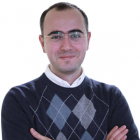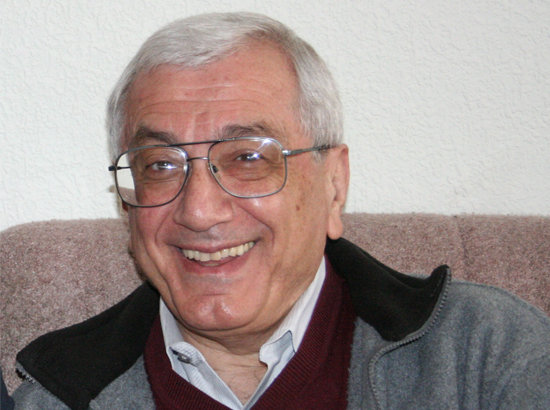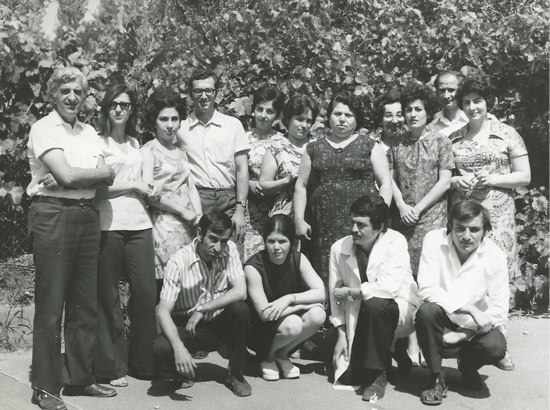Mediamax continues “50 global Armenians” special project and presents a new hero- physicist Alexandr Simonian, professor at Auburn University and foreign member of the National Academy of Sciences of Armenia.
Alexandr Simonian is a physicist. He was born and grew up in Yerevan. After finishing N76 School after Kamo in 1963, he entered the Faculty of Physics of the Yerevan State University. He graduated from YSU with honors and started working at the Physics Institute. In 1973, he received PhD degree. After the collapse of the Soviet Union he was invited to the University of Genoa, Italy and worked there in 1993-1994. The same year he received a Doctor of Science degree in Moscow. In 1994, he was invited to Texas University and worked there for 7 years. From 2003 till now he works at the University of Auburn, USA, Alabama. In 2011, he became a “foreign member” of the National Academy of Sciences of Armenia.
It would be good but also wrong to say that I studied at school. I was just lucky to have had a teacher who forced me to study well. Margarita Sargsyan was my mathematics teacher and I owe a lot to her. She has had an enormous influence not only on me but also on many pupils from my class. I became interested in physics in the 8th grade. I began reading books and finally fell in love with physics. At that time I was involved in the Armenian volleyball national team and often argued with my teammates. They persuaded me that sport is much better than physics. Being fond of sports, nevertheless I claimed the opposite.
When I entered the YSU in 1963, I had a strong desire to become a nuclear physicist and worked in that direction during 4 years. From the very beginning I have had close ties with the Physics Institute. Then I had a new professor who delivered lectures on biophysics and I decided to change my major and go deeper into this field. I joined the Physics Institute, the biophysics laboratory and my supervisor was Tsolak Avagyan. I think it was him who laid the foundation of biophysics in Armenia. 
The team of Radiation Biophysics Laboratory of Yerevan Physics Institute
In Soviet times, the Yerevan Physics Institute was a very powerful structure. The newly created biophysics laboratory had various directions - membrane physics, radiation genetics, etc. I joined the laboratory of membrane physics and in 1973 I received Ph.D. in Molecular Biophysics.
Having worked there for 6-7 years, Alexandr Simonian suddenly came across an article on enzymatic electrodes, which has had a revolutionary impact on his views. 
With Academician Evrik Afrikian
Besides the Yerevan Physics Institute, such a laboratory existed only in Vilnius (in USSR). So we became friends and rivals, as we worked in the same direction but in different ways. We formed a small group and had great success. We created an enzyme analyzer “Multiferm”, a flow-injection multipurpose amperometric biosensor system capable of quantization of glucose, uric acid, L-lysine, alcohol and phenols. We developed and manufactured it in a newly established cooperative “Biosensor”. Our analyzer was used at Charentsavan “Lysine” plant, the “Diagnosis” NGO in Moscow, and received a silver medal at the Exhibition of Economic Achievements in Moscow in 1989. The money we got from that project was invested into the further development of the product. In 1991, the Soviet Union collapsed, and we were back to square one.
At that time, Alexandr received an invitation from Italy, the University of Genoa.
I have worked for about a year in Italy. After returning to Armenia, a friend of mine invited me to the Agricultural and Mechanical University of Texas. The invitation was rather interesting. He said he knew what was going on in Armenia and invited me to Texas: he was ready to pay for all expenses, for my participation in the conference and for the accommodation during 3 months. I accepted the invitation, and in May 1994 I went to the United States for several months only, as I thought then...
I have worked for 8 years at the Texas University, the Biochemistry, Biophysics and Chemical Engineering Department. I was engaged in the detection of chemical warfare and pesticides. 
With renowned German biophysicist Frieder Scheller, 2005
In January 2003, Alexandr was invited to join the Mechanical Engineering Faculty of Auburn University, where he could continue his researches and teach. He agreed and moved to the state of Alabama.
The only difficulty I had in the USA was my poor English and it was quite hard for me to teach in English.
In 2007, I received an invitation from the U.S. National Science Foundation, which issued many grants. For about a year I was trying to launch a biosensors program and finally succeeded. I was in charge of the program till fall 2012.
With one of the heroes of “50 global Armenians” project, Gurgen Khachatrian, 2005
Alexandr’s children did not follow him, despite the fact that his son also graduated from the Faculty of Physics of the Yerevan State University, but later he changed his major.
My son Ruben was a second year student when the devastating earthquake hit Spitak in 1988. He got enrolled in the University’s “Spitak Detachment” and worked there for about 5 years. Later he worked in Moscow, received his MBA in the USA and set up his own business in Moscow. Now his company produces “Sanitelle” gels.
My daughter Marina graduated from the Faculty of Psychology of the Yerevan State University, and later also received her MBA and now she works at a large American company.

With grandchildren Vera and Mikael
Did the Soviet background help Alexandr or on the contrary?
It certainly did. We were trying to take all the best things from the Soviet system and were never interested in ideology. The Physics Institute, as I have already stated, was such a powerful structure that we did not even have contacts with the any officials. The science and the education were at a very high level. One of my friends has ironically said once: “if you have at least a little bit of brains, you are doomed to success in America.”
Auburn is a small University town lacking any entertainments except for work. I am fond of music, so I play or read in my free time. When I have a chance, I spend time with my grandchildren. We decided that they should speak not only English but also Armenian and Russian. My time is limited. I travel a lot to give lectures in different cities. For example, on March 3 (the interview was conducted in late February – Editor) I will be attending a conference in Italy, and will try to regain my knowledge of Italian.
Alexandr Simonian is a member of various communities, particularly the American Chemical Society and the International Union of Pure and Applied Chemistry (IUPAC). He is also a Member-Correspondent of the Armenian Academy of Engineers, the Member of the Presidium of the Armenian Biophysical Association. In 2011, he received a diploma of the foreign member of the National Academy of Sciences of Armenia. 
NAS President awards Alexandr Simonian the diploma of NAS foreign associate
I am trying to keep in touch with the Yerevan Physics Institute. I come to Yerevan every year, as my relatives live there. My heart is in Armenia.
I think that financially poor Armenia is unfortunately unable to develop such vital branches as the nuclear and accelerator physics, although it has registered huge achievements in these areas. In these circumstances, with the unconditional preservation of knowledge and people in these areas (which is a strategic necessity), we need to develop the areas where the powerful intellectual potential of the nation and the modest financial resources can become a good opportunity for our young people to realize their ambitions at home and will simultaneously bring a substantial economic benefit.
The almost inexhaustible supply of unique natural materials in combination with modern nanotechnology can be a solid basis for Materials Engineering.
With family
We have had and still have a powerful biotechnological industry. In conjunction with microbiology it can provide an opportunity to produce a large amount of products both for the internal market and for the export. Small chemistry has survived and now it supplies unique production to the global market. The brightest example of this is the Armenian Institute of Applied Chemistry, which synthesizes compounds having no analogues in the world. Another example can be the bio-technological waste processing, where the whole potential of people and knowledge can be used. It will clean the environment and produce energy. Academician Evrik Afrikian had a brilliant program which can be revived.
Aram Araratyan talked to Alexandr Simonian.






















Comments
Dear visitors, You can place your opinion on the material using your Facebook account. Please, be polite and follow our simple rules: you are not allowed to make off - topic comments, place advertisements, use abusive and filthy language. The editorial staff reserves the right to moderate and delete comments in case of breach of the rules.